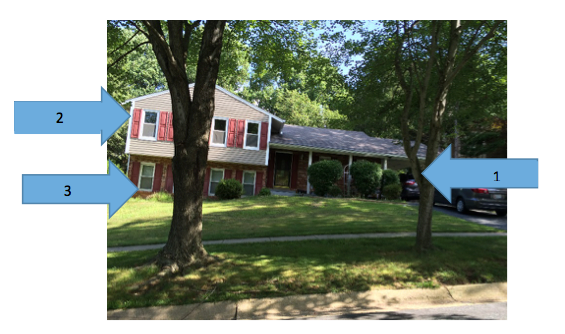
Everything You Ever Wanted to Ask An Appraiser
September 9, 2016By Kellie Wolfe
Residential appraising is both an art and a science. Both qualitative and quantitative analysis goes into valuing a property, and understanding of both macro and micro markets, FNMA/FHA requirements, and local building codes is critical to developing an estimate of market value for a property. With that said, there is rarely a cut and dry answer to any appraisal related question, but I will do my best to answer these frequently asked questions.
Bedrooms – What makes a room a bedroom?
It depends (this will not be the last time an answer begins this way, either, so bear with me)! This question is a matter of local building codes. Depending on the jurisdiction, the answer could involve the following components: a room with: an ingress/egress to the exterior in the form of a door or a window, access from a common space/hallway, and a closet. Building codes may also specify a requirement regarding the maximum height the base of a window can be from the floor, which can impact whether a room is classified as a bedroom or not.
The basic gist here is that a bedroom generally needs to be accessed from common space, have ingress/egress (a window or door), and a closet. Examples of rooms that would typically NOT be considered a bedroom: a room in the basement with a closet that has a window that is too small for an adult to fit through that is set all the way near the ceiling of the room; a room in a finished attic that is only accessible through a stairway in another bedroom.
Are upper level and main level bedrooms calculated as more valuable than basement bedrooms?
Typically, buyers assign more value to above grade (main and upper level) bedrooms than basement bedrooms, which is logical enough. Most people don’t want to sleep (or have their children) sleep full time in below grade space that is typically darker and finished in inferior quality materials. This is one of the reasons that below grade/basement area is treated separately from above grade/living area in the appraisal process.
Square Footage – How is square footage calculated?
This topic has a more definitive answer. Appraisers typically measure to ANSI (American National Standards Institute) standards, which also happen to correspond with Fannie Mae guidelines. When an appraiser comes to your property, he or she should measure the house and outbuildings from the exterior for a detached dwelling and from the  interior for a condominium unit or an interior townhouse. Using those measurements, square footage, or GLA (gross living area) is calculated.
interior for a condominium unit or an interior townhouse. Using those measurements, square footage, or GLA (gross living area) is calculated.
What is included? Excluded? Does the space have to be finished or just conditioned?
In order to be considered GLA, the space must meet the following criteria: it must be fully finished (finished walls, ceiling, floor coverings), heated (but not air conditioned), and it must be FULLY above grade. The “fully” above grade classification is of most concern in bilevel, split foyer, and split level style houses, which can be the most confusing when determining living area. GLA does NOT include garages, three season sunrooms that lack heat, finished attic space that is not accessible from a common hallway, or finished space that does not have a ceiling height adequate for an adult to stand under.
Here are some examples of what is and is not considered living area:
This is a split level style house. Level 1 contains the Living Room, Dining Room, and Kitchen. Level 2 contains the bedrooms and bathrooms (in this case four bedrooms and two full baths). Both Levels 1 and 2 are living area. Level 3 contains a Recreation Room, Bedroom, and a Half Bath. Level 3 is NOT part of the living area, because it is not FULLY above grade. The slope of the lot results in the windows closest to the front door being essentially at ground level. This is a sign that the level is partially below grade. Instead of being counted in the GLA, this square footage is considered part of the basement. This house has a Level 4 below Level 1. Level 4 cannot be seen in the photo because it is completely underground. Often this level will house the furnace and water heater, sometimes a laundry room, and will sometimes also feature finished space, but Level 4 is also considered to be basement.

This is a traditional colonial style house.The GLA for this house includes all the square footage on first and second floors with the exception of the garage and the area on the second floor that is open to the corresponding areas on the first floor. The open spaces in this house include a two story foyer and a two story family room. When calculating the FLA for this house, the appraiser would measure the exterior of the property and measure the interior of the garage, family room, and foyer, and then subtract out the square footage of those areas.
What is Taxable living area? Is it the same as square footage?
Taxable living area (TLA) and square footage are essentially the same thing, but reporting is not always consistent across jurisdictions. Take the split level house from the example above. The square footage (or GLA as we call it in appraising) includes only Levels 1 and 2. County assessors, however, sometimes include Level 3 in the reported TLA. The TLA of cape cod and bungalow style dwellings are often also reported inconsistently, particularly those that feature upper level bump outs or dormers that may not be able to be seen from the street by the assessors. The key in appraising is to know what the different jurisdiction/counties include in their reported TLA and to compare “apples to apples”.
During a real estate transaction, appraisers are given a copy of the sales contract before appraising a property. When appraising a refinance or home equity loan, are you given a target price?
When you approach an appraisal are you focused on justifying the price, disproving the price, or evaluating the property and then comparing the two values?
I would like to begin answering this question by explaining the purpose of an appraisal for lending, because I think that this something that a lot of borrowers do not exactly understand. The appraisal is for the LENDER, not for the buyer, seller, or borrower in a refinance transaction. The lender orders an appraisal of a property to analyze it as collateral for the loan (in real estate, a mortgage). The appraisal one of the factors considered by the lender when determining whether or not they want to take the risk associated with making a loan on the property.
Now that that’s out of the way… yes, for a purchase transaction, Fannie Mae requires appraisers to review and analyze the sales contract. We review the purchase price, ratification date, presence of seller concessions, conveyance of any personal property, and any other factors that might impact the negotiated price. Why is this relevant? I just appraised a house last month for a purchase and ALL the personal property including furniture and décor conveyed as part of the negotiated price. The personal property, however, cannot be considered in determining the market value of the real property and cannot be a  part of the collateral for the loan. In this case, the sales price was negotiated first and the sellers (who had moved out of the country) “threw in” the furniture after the fact, and it had no impact on the price.
part of the collateral for the loan. In this case, the sales price was negotiated first and the sellers (who had moved out of the country) “threw in” the furniture after the fact, and it had no impact on the price.
My job as an appraiser when doing an appraisal for a lender is to estimate the market value of a given property. Period. It is neither to prove nor disprove, support nor refute a sales price or estimate by another party. We are not given any sort of target value on refinances or HELOCs, because doing so could undermine objectivity, which is paramount in appraising. Lenders need an objective, uninfluenced opinion of value from appraisers in order to make lending decisions. I think that we can all look back on what happened ten years ago and see how lack of objectivity (among many other factors) could have contributed to the housing crisis.
What is your favorite thing about being an appraiser? What is your least favorite thing about being an appraiser?
There are so many things I love about being an appraiser. I love that my job is a little bit different every day. I get to meet so many people and see the way they’ve improved/renovated/decorated their houses, meet their pets, and sometimes get a tour of their houses by their children (who almost always love to show off their rooms)! I have seen everything from a 250 year old farm house to brand new custom construction. Sometimes the assignments are straightforward and easy, and other times they are extremely complex, like a puzzle, but I love appraising them all. And I love that this job gets me out from behind my desk for at least a little while every day, especially in the spring and fall when the weather is at its best here in the DMV.
Is there one thing you would like the public to know about appraisers that you think they don’t know?
As far as what I would like the public to know, I’d like to start with this: there is a lot more than goes into doing an appraisal that just the 15-60 minutes an appraiser is at your house. The part of the process you see as an agent or borrower is the easiest and least time consuming part. It is the data collection and analysis that takes the most time. The researching and selecting comparable sales, deriving and applying appropriate adjustments to those comparable sales, and then reconciling all that information into a final estimate of value are the most difficult, time consuming, and essential parts of the process. The field portion of the process may only take half an hour, but there are anywhere from four to twenty-four working hours or more worth of work that goes into generating one appraisal report.
Finally, there is one question that I’m often asked that I would like to answer here.
Is there anything the homeowner needs to do in preparation for the appraisal?
The answer is, no, there’s nothing that you as a borrower NEED to do before the appraisal, but there are definitely some things that you could do to make things easier for your appraiser.
First, if you have a copy of your plat, floor plan, architect’s drawings, etc. your appraiser would love to be able to review them. Having access to this sort of information helps the appraiser verify things like  easements, property boundaries, building dimensions, location of wells/septic fields, etc.
easements, property boundaries, building dimensions, location of wells/septic fields, etc.
Second, I encourage borrowers to give me a list, either written or verbal, of all improvements or renovation done to the property within the last 10-15 years. It does not have to be a detailed, to-the-penny list of items and associated costs, but knowing that a kitchen was fully remodeled and that the roof/windows/HVAC are less than five years old is information that the appraiser uses in determining the condition rating of the property. If you have handmade custom cabinetry in the kitchen or imported tiles in the bathrooms, let the appraiser know. Not every improvement or update will result in an increase in value, but I am a firm believer in the idea that you cannot have too much information in this case. A follow-up: if you are in the middle of any sort of renovations (like the kitchen, baths, basement, etc. – anything that is not going to be complete when the appraiser is at the house), please make sure that your lender and the appraiser are both aware. Depending on what work is being done, it can impact the appraisal.
Finally, you do not need to have the house “showing ready” like you would if you were selling. You do not need to worry about having every single thing picked up or put away, and it is OK that you have your coffee cup in the sink and folded laundry on your bed. You live in your house, and it is just fine for it to look like you live there!
Kellie Wolfe
Picket Fence Appraisals, LLC
Serving Maryland and Virginia
301-613-2261
info@picketfenceappraisalsllc.com
www.picketfenceappraisalsllc.com



